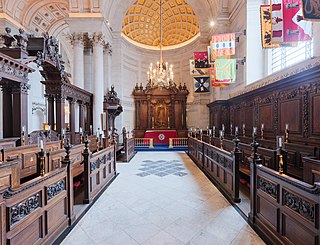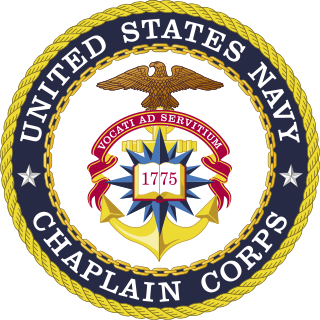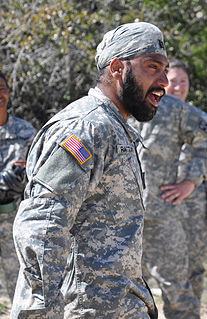
A church parade is a military parade by service personnel or members of a uniformed organization for the purposes of attending religious services. [1]

A church parade is a military parade by service personnel or members of a uniformed organization for the purposes of attending religious services. [1]
In October 1946 after debate in Parliament, the then–King’s Regulations paragraph 1605 was amended to read that "officers and soldiers will not be ordered to attend a religious service or to parade before a service or on returning from it".[ citation needed ]
In 1949 the issue was brought back to the table by the Church, and after six years of debate and consultation, it was written into the new 1955 Queen's Regulations. [2] [3]
In the Queen's Regulations[ when? ] it states: "J5.264. Sympathetic consideration is to be given to the needs of officially recognized religious minorities who do not profess the Christian faith. No one is to be compelled to attend divine service against his wishes (except as provided in para 5.268). All personnel of the armed forces under the age of 17 years may be ordered to attend divine service of their own denomination". [4] There are 5 sub sections in para 5.268. Sub-section e states: "Parades are not to be ordered in connection with divine service except that a CinC or GOC may order a parade which includes a religious service on special occasions of national or local importance. No officer or soldier on such a parade is to be compelled to take part in a service of any denomination other than his own or in any joint service. In special circumstances, authority to order such a parade may be delegated to local commanders". [4]
Military chaplains depended on a church parade to speak to the entire military formation. [5]

A religious denomination is a subgroup within a religion that operates under a common name, tradition, and identity.

A chapel is a Christian place of prayer and worship that is usually relatively small, and is distinguished from a church. The term has several senses. Firstly, smaller spaces inside a church that have their own altar are often called chapels; the Lady chapel is a common type of these. Secondly, a chapel is a place of worship, sometimes non-denominational, that is part of a building or complex with some other main purpose, such as a school, college, hospital, palace or large aristocratic house, castle, barracks, prison, funeral home, cemetery, airport, or a military or commercial ship. Thirdly, chapels are small places of worship, built as satellite sites by a church or monastery, for example in remote areas; these are often called a chapel of ease. A feature of all these types is that often no clergy were permanently resident or specifically attached to the chapel.

A chaplain is, traditionally, a cleric, or a lay representative of a religious tradition, attached to a secular institution such as a hospital, prison, military unit, intelligence agency, embassy, school, labor union, business, police department, fire department, university, sports club, or private chapel.

The units of the British Army are commanded by the Chief of the General Staff. This is broadly similar to the structures of the Royal Navy and Royal Air Force, in that the four-star (general-equivalent) commanders-in-chief have been eliminated since 2011 and service chiefs are given direct command of their respective services and are responsible as Top Level Budget (TLB) holders. Army Headquarters is located in Andover, Hampshire. There is a Commander Field Army and a personnel and UK operations command, Home Command.
In Ireland, the National Day of Commemoration commemorates all Irish people who died in past wars or United Nations peacekeeping missions. It occurs on the Sunday nearest 11 July, the anniversary of the date in 1921 that a truce was signed ending the Irish War of Independence. The principal ceremony is held at the Royal Hospital Kilmainham, Dublin, Ireland.

The Royal Army Chaplains' Department (RAChD) is an all-officer corps that provides ordained clergy to minister to the British Army.

The United States Navy Chaplain Corps is the body of military chaplains of the United States Navy who are commissioned naval officers. Their principal purpose is "to promote the spiritual, religious, moral, and personal well-being of the members of the Department of the Navy," which includes the Navy and the United States Marine Corps. Additionally, the Chaplain Corps provides chaplains to the United States Coast Guard.

A military chaplain ministers to military personnel and, in most cases, their families and civilians working for the military. In some cases they will also work with local civilians within a military area of operations.

The uniforms of the British Army currently exist in twelve categories ranging from ceremonial uniforms to combat dress. Uniforms in the British Army are specific to the regiment to which a soldier belongs. Full dress presents the most differentiation between units, and there are fewer regimental distinctions between ceremonial dress, service dress, barrack dress and combat dress, though a level of regimental distinction runs throughout.

A religious affairs specialist, previously known as chaplain assistant, is a member of the U.S. Army Chaplain Corps. This soldier provides expertise in religious support and religious support operations. The Religious Affairs Specialists, which is military occupational specialty (MOS) 56M, support the unit Chaplain and Commander in responding to the needs of soldiers, family members, and other authorized personnel. They act as counselors for their fellow Soldiers and provide security to Army chaplains. Duties include preparing spaces for worship, managing supplies, and ensuring the security and safety of the chaplain during combat situations.
The Australian Defence Force's (ADF) ranks of officers and enlisted personnel in each of its three service branches of the Royal Australian Navy (RAN), the Australian Army, and the Royal Australian Air Force (RAAF) inherited their rank structures from their British counterparts. The insignia used to identify these ranks are also generally similar to those used in the British Armed Forces.
The Australian Army Chaplains' Department is an all-officer Corps within the Australian Army that provides ordained clergy to minister to the personnel of the Australian Army. As of 2012, there are 67 serving regular chaplains in the Australian Army; these belong to either one of several Christian churches, or to the Jewish faith. There are also 83 chaplains in the Australian Army Reserve.

The CatholicMilitary Ordinariate of Australia, is a Latin Church suffragan military ordinariate of the Roman Catholic Church immediately subject to the Holy See. It was established in 1969 and managed for administrative purposes by the Archdiocese of Sydney.

Facial hair in the military has been at various times common, prohibited, or an integral part of the uniform.

There have been Sikhs in the United States military since World War I. Sikhs have served through all subsequent wars until the present day. Since the 1980s, observant Sikhs have faced difficulty in serving due to a discontinuation of exemptions to uniform standards which previously allowed Sikhs to maintain their religiously-mandated beards and turbans while in uniform.

Religious symbolism in the United States military includes the use of religious symbols for military chaplain insignia, uniforms, emblems, flags, and chapels; symbolic gestures, actions, and words used in military rituals and ceremonies; and religious symbols or designations used in areas such as headstones and markers in national cemeteries, and military ID tags.

United States military chaplains hold positions in the armed forces of the United States and are charged with conducting religious services and providing counseling for their adherents. As of 2011, there are about 2,900 chaplains in the Army, among the active duty, reserve, and National Guard components.

King's Chapel is a small chapel in the British Overseas Territory of Gibraltar. It is located at the southern end of Main Street and adjoins the Governor of Gibraltar's residence, The Convent. What nowadays is King's Chapel was the first purpose-built church to be constructed in Gibraltar. Originally part of a Franciscan friary, the chapel was built in the 1530s but was given to the Church of England by the British after the capture of Gibraltar in 1704. It was badly damaged in the late 18th century during the Great Siege of Gibraltar and in the explosion of an ammunition ship in Gibraltar harbour in 1951, but was restored on both occasions. From 1844 to 1990 it served as the principal church of the British Army in Gibraltar; since then it has been used by all three services of the British Armed Forces.

Center of Military Chaplaincy is a Ukrainian religious organization within the Curia of Lviv Archeparchy of the Ukrainian Greek-Catholic Church that works directly with Armed Forces of Ukraine. The Center of Military Chaplaincy provides counseling and pastoral care to officers, soldiers and their families.
The Army Chaplaincy Program of the Armenian Church is 50-member officer unit within the Armenian Armed Forces that provides ordained military chaplains and clergy to personnel of the Armenian Army. All members of the unit come from the Armenian Apostolic Church. It is jointly funded and sponsored by the Ministry of Defence of Armenia and the church. All army chaplains are commissioned officers in the armed forces who hold a military rank. They organize various religious programs in the military, including delivering lectures and prayers. It takes part in many ceremonies such as the induction of cadets of the Vazgen Sargsyan Military University. The current head of the military clergy is Bishop Vrtanes Abrahamyan.